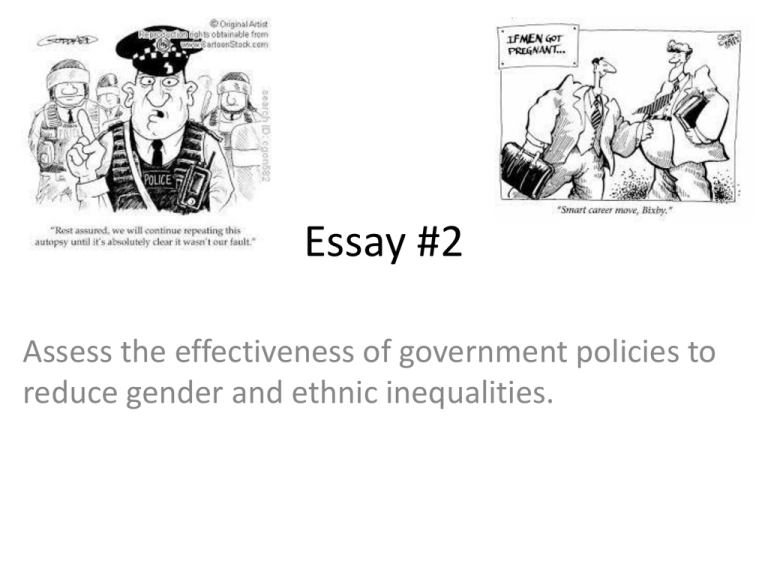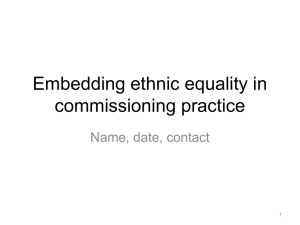
Essay #2
Assess the effectiveness of government policies to
reduce gender and ethnic inequalities.
Additional Information
• The full time gender pay gap at historic low (11.9% in Scotland), however
the Chartered Management Institute reported that it would not be until
2067 that pay equality would be achieved.
• Rise in number of female small business owners however women affected
disproportionately by Coalition’s benefit changes. Women still more likely
to suffer poverty, 30,000 women sacked per year for being pregnant.
• 2 million workers benefit from NMW- 75% of them women or ethnic
minorities.
• 2010 government report ‘Tackling Race Inequality: Statement on Race’
acknowledged progress in tackling racial inequality in UK. Success of
initiatives such as Ethnic Minority Employment Task Force and Black
Pupils Achievement Programme.
Assess the effectiveness of government policies to reduce
gender and ethnic inequalities.
•
•
•
•
Think about what inequalities exist
Then consider what the government has tried to do to fix them
Then what evidence shows there has been an improvement or not!
Remember to use the language from the question – effectiveness,
inequalities.
• REMEMBER MUST BE BALANCED
PEEB
Introduction
Government policies to reduce inequalities in gender and race have
been successful to some extent, there is still much to be achieved.
Unfortunately inequalities in both gender and race still exist despite
government attempts to remove them, there is still a pay gap between
men and women and ethnic minorities still feel discriminated against
by the police. The 2010 Equality act was a move to improve this, but
as the 2011 England riots proved, there is still racial discrimination and
perception of discrimination.
Middle Section – Aim for 4 paragraphs 2 for gender and two for race. Your
introduction and conclusion should cover both. You might want to structure your
arguments around the government attempts to reduce inequalities.
An example of
government
policy.
An example and
explanation to
assess the
effectiveness of
the policy.
A mini
conclusion
The government recognised a need to increase
equality between genders as far back as 1975,
when they introduced the Sex Discrimination
Act. This made it illegal to discriminate on the
basis of sex and was amended in 2006 to make
it illegal to sack women for pregnancy. Despite
these positive moves to reduce discrimination it
was not eradicated. In 2009 Gillian Williams
sacked from Airlink Management services for
being pregnant, however, due to the legislation
she was granted compensation of £5000. The
unfairness of her position was recognised
under the law, and this was just one case which
was upheld and encourages businesses to be
more gender equal. This shows the policy was
effective to a small extent.
Middle Section – Continued, 3 more key arguments to structure your response
Use facts you have
discovered during your
investigation and the
Gender and Race
information provided to
explain the policies and
give examples and
explanations which
demonstrate how
effective, in other words
how successful the
policies have been.
2-2010 Equality Act with regards to
women. What is it and how effective was
it. Use and example and explanation as
evidence to back up your argument. Mini
conclusion with regards to the question.
3-1976 Act &2003 MacPherson report with
regards to ethnicity. What is it and how
effective was it. Use and example and
explanation as evidence to back up your
argument. Mini conclusion with regards to
the question.
4-Equality Act with regards to race. What is
it and how effective was it. Use and
example and explanation as evidence to
back up your argument. Mini conclusion
with regards to the question.
Link to question
– use language
from question
Qualify the
effectiveness –
very, greatly,
not at all, to
some extent…
No new
argument, but
new evidence if
relevant.
Conclusion
Look at the question again, review
your arguments and examples and
sum up. Only really has to be 3
sentences. Don’t introduce new
arguments here, but you can
introduce a new piece of evidence
to back up your position.
Remember what you said in your
introduction and conclusion and
don’t contradict yourself.
Make sure your
argument
flows!









